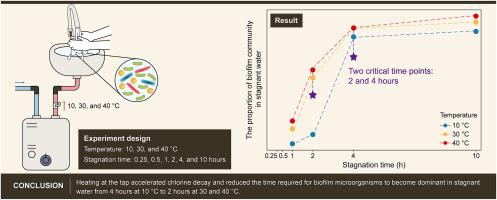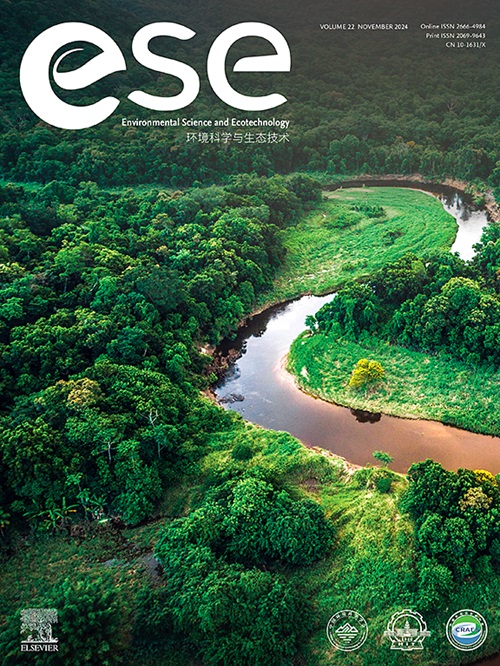在短期停滞期间,非接触式传感器水龙头中的温度依赖微生物动力学
IF 14.3
1区 环境科学与生态学
Q1 ENVIRONMENTAL SCIENCES
引用次数: 0
摘要
建筑管道系统中的微生物污染在使用点对公众健康构成重大风险。停滞和温暖的温度是众所周知的微生物再生的驱动因素,但在广泛用于卫生和舒适的非接触式传感器水龙头中,常见的短期停滞的影响仍然知之甚少。在这里,我们展示了在不同温度(10、30和40°C)下,非接触式传感器水龙头中的微生物水质在短期停滞(0.25-10小时)期间的变化。我们确定了两个关键时间点- 2和4h -微生物多样性下降,嗜肺军团菌浓度显著增加,由加速氯衰变和生物膜贡献驱动。加热至30°C可使微生物生物量(以ATP衡量)最大化,但使嗜肺乳杆菌增殖最小化,而加热至40°C可减少生物量,同时促进嗜肺乳杆菌生长。这些研究结果表明,温度相关的微生物水质保证期为2-4小时,超过这个时间就需要冲洗以减轻健康风险。优化30至40°C之间的水龙头温度可以平衡微生物安全,用户舒适度和能源效率,为现代管道系统中的水质管理提供实用指导。本文章由计算机程序翻译,如有差异,请以英文原文为准。

Temperature-dependent microbial dynamics in touchless sensor faucets during short-term stagnation
Microbial contamination in building plumbing systems poses significant risks to public health at the point of use. Stagnation and warm temperatures are well-known drivers of microbial regrowth, but the effects of common short-term stagnation in touchless sensor faucets—widely used for hygiene and comfort—remain poorly understood. Here we show that microbial water quality in touchless sensor faucets changes during short-term stagnation (0.25–10 h) at varying temperatures (10, 30, and 40 °C). We identify two pivotal time points—2 and 4 h—where microbial diversity decreases and Legionella pneumophila concentrations increase significantly, driven by accelerated chlorine decay and biofilm contributions. Heating to 30 °C maximizes microbial biomass (measured as ATP) but minimizes L. pneumophila proliferation, whereas 40 °C reduces biomass while promoting L. pneumophila growth. These findings reveal a temperature-dependent microbial water quality guarantee period of 2–4 h, beyond which flushing is necessary to mitigate health risks. Optimizing faucet temperatures between 30 and 40 °C could balance microbial safety, user comfort, and energy efficiency, offering practical guidance for managing water quality in modern plumbing systems.
求助全文
通过发布文献求助,成功后即可免费获取论文全文。
去求助
来源期刊

Environmental Science and Ecotechnology
Multiple-
CiteScore
20.40
自引率
6.30%
发文量
11
审稿时长
18 days
期刊介绍:
Environmental Science & Ecotechnology (ESE) is an international, open-access journal publishing original research in environmental science, engineering, ecotechnology, and related fields. Authors publishing in ESE can immediately, permanently, and freely share their work. They have license options and retain copyright. Published by Elsevier, ESE is co-organized by the Chinese Society for Environmental Sciences, Harbin Institute of Technology, and the Chinese Research Academy of Environmental Sciences, under the supervision of the China Association for Science and Technology.
 求助内容:
求助内容: 应助结果提醒方式:
应助结果提醒方式:


